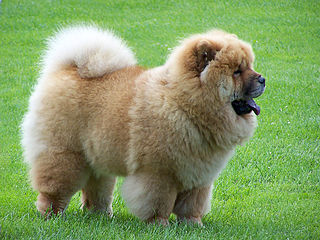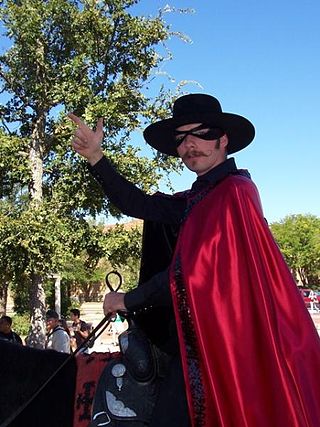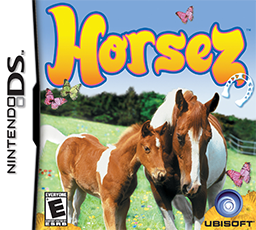
The horse is a domesticated, one-toed, hoofed mammal. It belongs to the taxonomic family Equidae and is one of two extant subspecies of Equus ferus. The horse has evolved over the past 45 to 55 million years from a small multi-toed creature, close to Eohippus, into the large, single-toed animal of today. Humans began domesticating horses around 4000 BCE, and their domestication is believed to have been widespread by 3000 BCE. Horses in the subspecies caballus are domesticated, although some domesticated populations live in the wild as feral horses. These feral populations are not true wild horses, which are horses that never have been domesticated. There is an extensive, specialized vocabulary used to describe equine-related concepts, covering everything from anatomy to life stages, size, colors, markings, breeds, locomotion, and behavior.

The Chow Chow is a spitz-type of dog breed originally from northern China. The Chow Chow is a sturdily built dog, square in profile, with a broad skull and small, triangular, erect ears with rounded tips. The breed is known for a very dense double coat that is either smooth or rough. The fur is particularly thick in the neck area, giving it a distinctive ruff or mane appearance. The coat may be shaded/self-red, black, blue, cinnamon/fawn, or cream.

Horses can use various gaits during locomotion across solid ground, either naturally or as a result of specialized training by humans.

The Icelandic horse is a breed of horse developed in Iceland. Although the horses are small, at times pony-sized, most registries for the Icelandic refer to it as a horse. Icelandic horses are long-lived and hardy. In their native country they have few diseases; Icelandic law prevents horses from being imported into the country and exported animals are not allowed to return. In addition to the gaits of walk, trot, and canter/gallop typical of other horse breeds, many Icelandic horses can also do the tölt and the flying pace. The only breed of horse in Iceland, they are also popular internationally, and sizable populations exist in Europe and North America. The breed is still used for traditional sheepherding work in its native country, as well as for leisure, showing, and racing.
Canine terminology in this article refers only to dog terminology, specialized terms describing the characteristics of various external parts of the domestic dog, as well as terms for structure, movement, and temperament. This terminology is not typically used for any of the wild species or subspecies of wild wolves, foxes, coyotes, dholes, jackals or the basal caninae. Dog terminology is often specific to each breed or type of dog. Breed standards use this terminology in the description of the ideal external appearance of each breed, although similar characteristics may be described with different terms in different breeds.

"English pleasure" is the generic term for a number of different English riding classes seen at horse shows in the United States, where the horse is ridden in either hunt seat or saddle seat tack.

Ticket to Ride is a railway-themed German-style board game designed by Alan R. Moon. It was illustrated by Julien Delval and Cyrille Daujean and published in 2004 by Days of Wonder. The game is also known as Zug um Zug (German), Les Aventuriers du Rail (French), Aventureros al Tren (Spanish), Wsiąść do pociągu (Polish), and Menolippu (Finnish).

Hunt seat is a style of forward seat riding commonly found in North American horse shows. Along with dressage, it is one of the two classic forms of English riding. The hunt seat is based on the tradition of fox hunting. Hunt seat competition in North America includes both flat and over fences for show hunters, which judge the horse's movement and form, and equitation classes, which judge the rider's ability both on the flat and over fences. The term hunt seat may also refer to any form of forward seat riding, including the kind seen in show jumping and eventing.

An ambling gait or amble is any of several four-beat intermediate horse gaits, all of which are faster than a walk but usually slower than a canter and always slower than a gallop. Horses that amble are sometimes referred to as "gaited", particularly in the United States. Ambling gaits are smoother for a rider than either the two-beat trot or pace and most can be sustained for relatively long periods, making them particularly desirable for trail riding and other tasks where a rider must spend long periods in the saddle. Historically, horses able to amble were highly desired for riding long distances on poor roads. Once roads improved and carriage travel became popular, their use declined in Europe but continued in popularity in the Americas, particularly in areas where plantation agriculture was practiced and the inspection of fields and crops necessitated long daily rides.

The Masked Rider is the primary mascot of Texas Tech University. It is the oldest of the university's mascots still in existence today. Originally called "Ghost Rider", it was an unofficial mascot appearing in a few games in 1936 and then became the official mascot with the 1954 Gator Bowl. The Masked Rider has led the team onto the field at nearly every football game since. It is the nation's first school mascot to feature a live horse at a football game, ahead of Florida State's Chief Osceola and Renegade and 25 years before USC's Traveler and all other such mascots in existence today.

Gallop Racer is a series of horse racing video games, created by Tecmo.

Western riding is considered a style of horse riding which has evolved from the ranching and welfare traditions which were brought to the Americas by the Spanish Conquistadors, as well as both equipment and riding style which evolved to meet the working needs of the cowboy in the American West. At the time, American cowboys had to work long hours in the saddle and often over rough terrain, sometimes having to rope a cattle using a lariat, also known as a lasso. Because of the necessity to control the horse with one hand and use a lariat with the other, western horses were trained to neck rein, that is, to change direction with light pressure of a rein against the horse's neck. Horses were also trained to exercise a certain degree of independence in using their natural instincts to follow the movements of a cow, thus a riding style developed that emphasized a deep, secure seat, and training methods encouraged a horse to be responsive on very light rein contact.

Horsez is a video game released by Ubisoft on October 26, 2006, for the Nintendo DS, PlayStation 2, PC and Game Boy Advance. This PC game is the sequel to Champion Dreams: First to Ride and is also part of the second series of Petz. The user plays as Flora, a new member of the Sycamore Academy. Players select a horse from one of five breeds and a range of colours. The player trains their horse in different disciplines, enters shows, cares for the horse, and after a few weeks gains a foal to raise.

Horse grooming is hygienic care given to a horse, or a process by which the horse's physical appearance is enhanced for horse shows or other types of competition.
Barbie Horse Adventures is a series of video games based on Mattel's Barbie line of dolls. The series is aimed at children and involves various aspects of equestrianism.

My Pokémon Ranch is a Pokémon video game developed for the Wii by Ambrella and published by The Pokémon Company. My Pokémon Ranch was released via the WiiWare download service on March 25, 2008, in Japan, in the Americas on June 9, 2008, and in Europe on July 4, 2008.

Epona is a recurring fictional horse in The Legend of Zelda series of video games that debuted in Ocarina of Time. She was created by Yoshiaki Koizumi as the main form of transportation and steed of Link, the series protagonist. Her name is derived from the Celtic goddess of horses of the same name. Epona appears in several main titles in The Legend of Zelda series, including Majora's Mask, Twilight Princess, Breath of the Wild, and Tears of the Kingdom. She also appears in the spin-off title Hyrule Warriors and other game series.

My Horse & Me is a show jumping video game published by Atari Europe for the Nintendo Wii, Nintendo DS, and Windows. It is the first game released by Atari under their exclusive partnership with the FEI.

Pippa Funnell 2: Take the Reins is a horse riding simulation game developed by French studio Lexis Numerique and released by Ubisoft on October 27, 2006 for the PlayStation 2 and Windows. The player takes the role of Jade as she attends the Sycamore Riding School in Scotland. Throughout the game, the player is able to train, care for, and compete with their horse while interacting with the other students in the Academy, and solving a mystery.

Thunder is the stage name for the horse who is the official live animal mascot for the Denver Broncos football team. Thunder shares mascot duties with Miles, a human who wears a horse head mask atop a Broncos uniform.


















